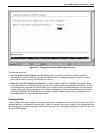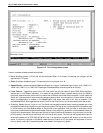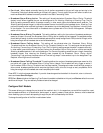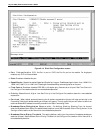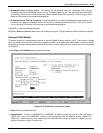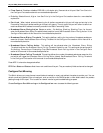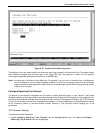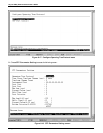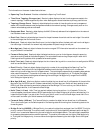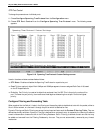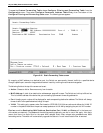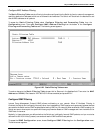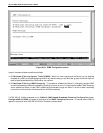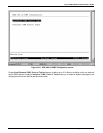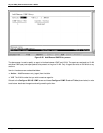
24-port NWay Ethernet Switch User’s Guide
46 Using the Console Interface
The information on the screen is described as follows:
♦ Spanning Tree Protocol Enables or disables the Spanning Tree Protocol.
♦ Time Since Topology Changes (sec) Read-only object displays the last time changes were made to the
network topology. These changes usually occur when backup paths are activated due to primary path failures.
♦ Topology Change Count Read-only object displays the number of times (since the current management
session with the device was started) changes were made to the network topology. Changes usually occur on the
network when backup paths are activated.
♦ Designated Root Read-only object displays the MAC (Ethernet) address of the bridge/switch on the network
that has been chosen as the STP root.
♦ Root Cost Read-only object displays the cost for the path between the switch and the root bridge. If the switch
is the root bridge, then the root cost is zero.
♦ Root port Read-only object identifies the port (on the bridge) that offers the least path cost from the bridge to
the root bridge. In the event of a network loop, data packets will pass through the root port.
♦ Max Age (sec) Read-only object indicates the maximum age of STP information learned from the network (on
any port) before it is discarded.
♦ Forward Delay (sec) Read-only object indicates how fast any port on the bridge can change its spanning
state when moving towards the forwarding state. The value determines how long the port stays in each of the
listening and learning states, which precede the forwarding state.
♦ Hold Time (sec) Read-only object displays the time interval during which no more than two configuration BPDUs
shall be transmitted by the bridge.
♦ Root Priority Read-only object displays the priority number of the root bridge of the Spanning Tree. The
value is used in conjunction with the bridge MAC address to set the bridge ID, which in turn is used when
determining the root bridge of a multi-bridged network. The root bridge is responsible for processing data packets
when network loops occur. The smaller the number set, the higher the bridge priority is. The higher the bridge
priority, the more chance the bridge has of becoming the root bridge. A bridge priority ranges from 0 to 65535,
with 0 being the highest priority.
♦ Max Age (6-40 sec) Maximum Age is a read-write object that can be set from 6 to 40 seconds. At the end of the
Maximum Age, if a BPDU has still not been received from the Root ridge, your Switch will start sending its own
BPDU to all other switches for permission to become the Root Bridge. If it turns out that your Switch has the
lowest Bridge Identifier, it will become the Root Bridge.
♦ Hello Time (1-10 sec) Hello Time is a read-write object that can be set from 1 to 10 seconds. This is the
interval between two transmissions of BPDU packets sent by the Root Bridge to tell all other switches that it is
indeed the Root Bridge. If you set a Hello Time for your Switch, and it is not the Root Bridge, the set Hello Time
will be used if and when your Switch becomes the Root Bridge.
♦ Forward Delay (4-30 sec) The Forward Delay is a read-write object that can be set from 4 to 30 seconds.
This is the time any port on the Switch spends in the listening state while moving from the blocking state to the
forwarding state.
♦ Bridge Priority (0-65535) A Bridge Priority is a read-write object that can be set from 0 to 65535. This is the
priority number of the bridge. The value is used in conjunction with the bridge MAC address to set the bridge ID,
which in turn is used when determining the root bridge of a multibridged network. The root bridge is responsible
for processing data packets when network loops occur. The smaller the number set, the higher the bridge priority
is. The higher the bridge priority, the more chance the bridge has of becoming the root bridge. Zero is the highest
priority.



